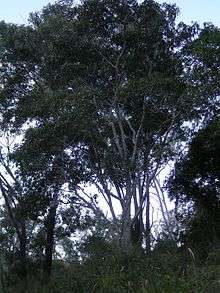Pleiogynium timoriense
Pleiogynium timoriense, commonly known as the Burdekin plum, is a medium-sized fruit-bearing tree native to Malesia, Australia and the Pacific Islands.[1]
| Pleiogynium timoriense | |
|---|---|
 | |
| Scientific classification | |
| Kingdom: | Plantae |
| Clade: | Tracheophytes |
| Clade: | Angiosperms |
| Clade: | Eudicots |
| Clade: | Rosids |
| Order: | Sapindales |
| Family: | Anacardiaceae |
| Genus: | Pleiogynium |
| Species: | P. timoriense |
| Binomial name | |
| Pleiogynium timoriense | |
| Synonyms | |
| |
Description
This semi-deciduous large tree can naturally reach up to 20 m high with a plank buttresses. but in cultivation generally grows to approximately 12 m. It has a dense canopy with glossy dark green leaves 4-10 x 2-6 cm and the trunk has rough dark bark. Leaflets commonly number 5 to 11, are arranged opposite, elliptic to ovate in shape, with a true terminal leaflet. The stalk of the terminal leaflet is significantly longer than those of the lateral leaflets. There are prominent domatia on the underside of leaflets.[2]
The tree has yellowish-green dioecious flowers which appear between January and March, and later (after pollination) grow into a fruit. The flower calyx lobes are about 0.6-1 mm long, with ovate petals about 1.7-3.8 mm long. Filaments are about 1.3-2.3 mm long.
The fruit is a depressed-obovoid drupe, about 20-25 x 20-38 mm. The fruit's flesh is generally plum-coloured (dark purple), however, white varieties have been reported. The fruit is edible when ripe.[3]
 fruits & seeds
fruits & seeds fruits
fruits Unripe fruits
Unripe fruits- Leaves
 Bark
Bark Tree
Tree
Fruit must be removed from tree to ripen for several days in a dark, damp place. Indigenous people are known to have buried the fruit underground to ripen. Fruit can be cooked, eaten raw or used in jellies, jams and preserves.[4][5][6]
Distribution
The species occurs in Indonesia, Malaysia, Papua New Guinea, the Philippines, Australia (south-eastern Queensland), the Cook Islands, Fiji, the Solomon Islands and Tonga[1] at elevations from sea level to 1000 meters. It grows in drier rain forest and monsoon forest[3]. In Queensland, the species occurs in dry rainforest, littoral and subcoastal riverine rainforest north from around Gympie.[2]
References
- "Pleiogynium timoriense, Pleiogynium timoriense". Germplasm Resources Information Network (GRIN). Agricultural Research Service (ARS), United States Department of Agriculture (USDA). Retrieved 24 July 2013.
- Williams, J.B.; Harden, G.J.; McDonald, W.J.F. (1984). Trees & Shrubs in Rainforests of New South Wales & Southern Queensland (First ed.). Australia: Botany Department, University of New England. p. 141. ISBN 0 85834 555 2.
- "Factsheet - Pleiogynium timorense". TRIN Interactive Key Services. Retrieved 7 May 2019.
- Pleiogynium timorense
- "Burdekin Plum". Bush Tucker. SGAP(Qld).
- Pleiogynium timorense
Further reading
- Netzel, Michael; Netzel, Gabriele; Tian, Qingguo; Schwartz, Steven; Konczak, Izabela (22 November 2006). "Sources of Antioxidant Activity in Australian Native Fruits. Identification and Quantification of Anthocyanins". Journal of Agricultural and Food Chemistry. 56 (26): 9820–6. doi:10.1021/jf0622735. PMID 17177507.
External links
- "Pleiogynium timoriense (DC.) Leenh". Atlas of Living Australia.

